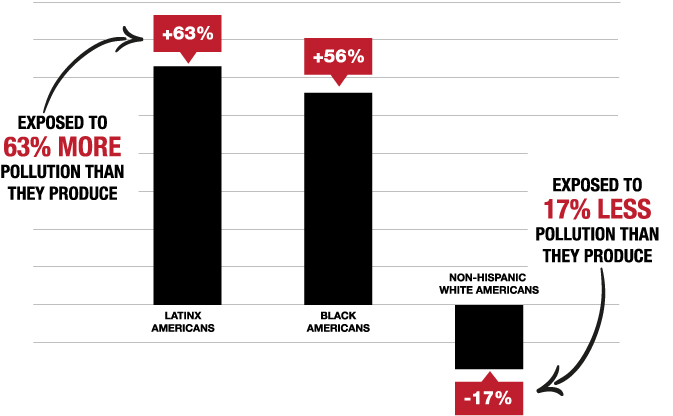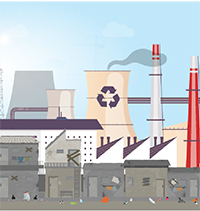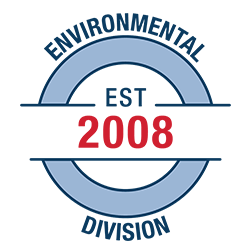Environmental Justice in the World of Insurance
Environmental Justice has been a focal point under the Biden Administration and recent actions taken by the Environmental Protection Agency (EPA) signal a shift toward increased oversight and enforcements against industries that affect disadvantaged communities. Some suggest that sweeping environmental justice regulations will directly impact many current operations and be a deciding factor when siting future industries.1
So what exactly is environmental justice? Where did the national movement originate? What future impacts may emerge? Which considerations warrant attention while evaluating environmental insurance coverage? Let’s dive into these questions.
What is Environmental Justice?
Despite progress in the United States, a long history of racial discrimination and economic disparity has resulted in underprivileged communities facing the unequal burden of pollution and climate change. It is well documented that communities of color and low-income populations reside in some of the most polluted areas, and those populations most immediately and severely affected by the results of climate change are often those without resources to respond.2

Per the National Law Review, “Environmental justice is the concept that all people – regardless of race, color, national origin, or income – should receive fair treatment and have meaningful involvement with respect to the development, implementation, and enforcement of environmental laws, regulations, and policies.” 3
In short, environmental justice embraces the principle that all communities and all people in any location have the right to equal protection under our environmental laws.
History of Environmental Justice
While environmental justice seems to be a trending topic these days, community activists have been fighting the battle for decades.

1969: Hazel Johnson, who some refer to as the “mother of Environmental Justice,” began pushing for more equitable conditions in Chicago. As an African American resident of low-income public housing, Johnson watched her family members and neighbors suffer from adverse health and safety conditions because of various nearby landfills, industrial operations and wastewater discharges.4 Johnson sought to fight environmental racism and petitioned local officials and state agencies for broad reform in these most vulnerable “fence line” communities.
.jpg?sfvrsn=88d259b1_2)
1994: While community activism helped push environmental justice forward on a local and regional level, environmental justice did not reach a national stage until the mid-1990’s. In 1994, President Bill Clinton signed an Executive Order (EO 12898) which instructed the different federal agencies to develop their own environmental justice policies that would limit the “disproportionately high and adverse” effects of environmental harms on low-income communities and people of color – generally, those who are more likely to be burdened by pollution and/or contaminated water sources.5 Under this order, the Environmental Justice Advisory Council was also empowered to influence the priorities of the EPA.
However, at the time, President Clinton’s executive order lacked concrete requirements that environmental justice be considered in siting, rulemaking and permitting decisions, and more importantly, it did not create a framework for judicial review regarding compliance with the executive order. To that end, this meant that no person or organization could try to ensure that the order was enforced to any degree.
.jpg?sfvrsn=9cd259b1_2)
2014: Nevertheless, the executive order still brought national attention to environmental justice issues and by 2014, all states had enacted similar policies requiring state agencies address environmental justice.6
Environmental Justice under the Biden Administration
Fast forward to present day, environmental justice has been reinvigorated on a national level under the Biden administration. Within the first weeks of taking office, President Biden issued his own Executive Order (EO 14008) which articulated the commitment to address environmental justice issues including inequity due to climate change.
The executive order created three (3) new committees focusing on environmental justice including:
- The White House Interagency Council on Environmental Justice (CEJ)
- An Office of Health and Climate Equity at the Health and Human Services Department
- An Environmental Justice Office within the Justice Department
Where previously the U.S. Environmental Protection Agency (EPA) led oversight and environmental justice implementation efforts, the new White House Interagency Council on Environmental Justice is comprised of many federal agencies – Agriculture, Defense, Labor, Housing, Energy, Environment, Transportation, etc. – which expand the reach of environmental justice. Per the executive order, the Council on Environmental Justice will be tasked with developing strategies to address current and historic environmental injustice, developing clear performance metrics for federal agencies to ensure accountability, and publishing performance scorecards on environment justice implementation publicly. 7
Biden’s executive order also stipulated that 40% of federal sustainability investments must benefit disadvantaged ‘fence line’ communities, which shoulder undue pollution burdens. The initiative, which has been touted as the “Justice 40 Initiative,” could include investments in clean energy, clean transit, affordable housing and clean water infrastructure.8 The initiative is already being put into action.
For example, in early May 2021, the U.S. Department of Energy allocated more than 15 million dollars of funding to install solar energy in low-income communities and to train community members interested in the trade.9
EPA Guidance and Potential Future Impacts – What Does This Mean?
Aside from increased investments into disadvantaged communities, many expect increased scrutiny and enforcement resulting from this administration’s renewed focus on environmental justice.
“Some have surmised that President Biden’s early efforts point toward further policy and legal changes that could shape the regulatory landscape over the coming years." 10
The National Law Review suggests that companies with facilities located in vulnerable environmental justice areas should expect heightened scrutiny moving forward, including potential civil or criminal penalties.11,12 Facility owners and operators should expect a number of changes related to enhanced regulatory scrutiny of certain sites, changes in enforcement and enforcement terms, increased facility inspections from governmental agencies and an increased demand for monitoring, notification and community engagement. With the Biden administration’s renewed emphasis on environmental justice, some forewarn that companies which own or operate facilities should pay close attention to any environmental justice metrics which may apply. Chemical facilities, power plants, treatment plants, refineries and heavy metal plants are likely to be the operations most commonly targeted.13
The federal focus on environmental justice has spurred many states to pursue their own environmental justice initiatives. As the current trend for specific requirements at the state and federal level builds, environmental justice could become depoliticized and be a baseline industry expectation like NPDES permitting or air emissions standards.
At the state level, states like New Jersey, Massachusetts and Connecticut have enacted or are in the process of drafting updated regulations which will have substantive environmental justice requirements for existing and future industry permitting. In New Jersey, an Environmental Justice Impact Statement will be a prerequisite for all permit applications and renewals for certain qualifying facilities.14 New Jersey DEP is still in the process of determining the guidelines for implementing and enforcing the new Environmental Justice Law, however.15
All this supports the notion that environmental justice will be a central focus for environmental engagement moving forward. And with the interagency council expanding focus beyond the purview of the EPA, environmental justice principles, initiatives and enforcement actions might now, and in the future, be seen across all federal agencies and more widely in state regulations as well.
Recent Environmental Justice Claims
As the focus on environmental justice intensifies, there has been an increasing number of lawsuits filed in recent months revolving around the issues.
In April, the City of Los Angeles filed suit against a scrap metal recycling facility operating in southern Los Angeles.

The area surrounding the facility, which includes the nearby Watts neighborhood, are considered some of the most disadvantaged areas in the state of California.

Operations at S&W Atlas Iron & Metal Co. Inc. have reportedly subjected this community to metal shards, projectiles, and noxious fumes for a prolonged period. Outdoor recreational space at a nearby high school even had metal shards piling to heights of 20+ feet.

The suit alleges that the disadvantaged community shouldered the primary burden of the environmental hazards created by the scrap yard, and in May 2021, the State of California joined the suit to pursue damages against S&W Atlas.16
Environmental Protection
While the focus on environmental justice continues to heighten, many sites within targeted industries may be subject to additional environmental testing, leading to fines or other penalties. When assessing properties in geographic locations subject to environment justice regulations, it is important to partner with a knowledgeable carrier who can help properly mitigate the risks and address the coverage considerations described above. Contact your underwriter today to learn more about how our core products and services can help protect your clients’ operations.


Footnotes
- 1 https://www.natlawreview.com/article/environmental-justice-and-why-you-should-care
- 2 https://www.nytimes.com/2019/09/05/us/politics/environmental-justice-climate-town-hall.html
- 3 https://www.natlawreview.com/article/environmental-justice-and-why-you-should-care
- 4 https://grist.org/equity/hazel-johnson-environmental-justice-month-chicago/
- 5 https://grist.org/politics/joe-biden-environmental-justice-executive-order-bill-clinton/
- 6 https://grist.org/politics/joe-biden-environmental-justice-executive-order-bill-clinton/
- 7https://www.natlawreview.com/article/environmental-justice-and-why-you-should-care
- 8 https://grist.org/politics/joe-biden-environmental-justice-executive-order-bill-clinton/
- 9 https://www.energy.gov/articles/doe-launches-initiatives-accelerate-solar-deployment-underserved-communities
- 10 https://news.bloomberglaw.com/environment-reporter/biden-epa-sends-early-signal-of-aggressive-pollution-enforcement
- 11 https://www.natlawreview.com/article/environmental-justice-and-why-you-should-care
- 12 https://news.bloomberglaw.com/environment-reporter/biden-epa-sends-early-signal-of-aggressive-pollution-enforcement
- 13 Ebid
- 14 https://www.erisinfo.com/podcasts/episode-7-spotlight-new-jerseys-environmental-justice-law-means-industry/
- 15 https://www.nj.gov/governor/news/news/562020/20200918a.shtml
- 16 https://www.law360.com/environmental/articles/1389875/calif-seeks-to-join-la-environmental-justice-suit
- 17 https://www.natlawreview.com/article/environmental-justice-and-why-you-should-care
- 18 https://www.nj.gov/governor/news/news/562020/20200918a.shtml
- 19 https://hudsonreporter.com/2021/05/11/environmental-justice-lawsuit-filed-against-secaucus-business/
- 20 https://www.hklaw.com/en/insights/publications/2021/04/environmental-justice-in-the-biden-administration
- 21 https://seas.umich.edu/news/environmental-justice-screening-tools
- 22 https://www.nj.gov/dep/ej/
References
- https://www.epa.gov/sites/production/files/2021-04/documents/strengtheningenforcementincommunitieswithejconcerns.pdf
- https://news.bloomberglaw.com/environment-reporter/biden-epa-sends-early-signal-of-aggressive-pollution-enforcement
- https://www.natlawreview.com/article/environmental-justice-and-why-you-should-care
- https://www.nytimes.com/2019/09/05/us/politics/environmental-justice-climate-town-hall.html
- https://grist.org/equity/hazel-johnson-environmental-justice-month-chicago/
- https://grist.org/politics/joe-biden-environmental-justice-executive-order-bill-clinton/
- https://www.energy.gov/articles/doe-launches-initiatives-accelerate-solar-deployment-underserved-communities
- https://www.hklaw.com/en/insights/publications/2021/04/environmental-justice-in-the-biden-administration
- https://www.erisinfo.com/podcasts/episode-7-spotlight-new-jerseys-environmental-justice-law-means-industry/
- https://www.eenews.net/stories/1063732139
- https://seas.umich.edu/news/environmental-justice-screening-tools
- https://www.epa.gov/ejscreen
- https://ejscreen.epa.gov/mapper/
- https://oehha.ca.gov/calenviroscreen/report/calenviroscreen-30
- https://oehha.ca.gov/calenviroscreen
- https://echo.epa.gov/facilities/facility-search
- https://www.law360.com/environmental/articles/1389875/calif-seeks-to-join-la-environmental-justice-suit
- https://www.insidernj.com/press-release/piscataway-residents-sue-zoning-board-stop-warehouses-next-school-park/
- https://hudsonreporter.com/2021/05/11/environmental-justice-lawsuit-filed-against-secaucus-business/
- https://www.washingtonpost.com/climate-environment/2021/05/14/limetree-bay-refinery/